GM’s Pontiac division ceased to be some 13 years ago. Because by that time, it had become a marketing facade for other GM vehicles, re-selling Chevys and Buicks that were largely the same under their skins. Even the very last-gasp attempt to give Pontiac something not just different but unique to Pontiac failed. That being the Solstice roadster, which was also a Saturn Sky roadster.
Neither Saturn nor Pontiac exist anymore.
Things might have been different for Pontiac if GM had not put the kibosh on the last Pontiac V8, which was uniquely Pontiac and so different from everything else.
This was the 301 V8 (4.9 liters, in the anodyne metric-speak that began to take over engine displacement etymology in the late 1970s) which was also produced in smaller displacements that few remember. It was the 301, though, that people who still remember Pontiac remember – probably because it powered the last Pontiac Trans-Ams, which were made in 1980 and 1981.
Pontiac continued to sell Trans-Ams after that – and all the way through 2002 – but they were all Chevy-engined and so facades of Pontiac. This is not to say the ’82-2002 Trans-Ams were bad cars because their Chevy Camaro Z28 analogs certainly weren’t. But what they were not was Pontiacs, in any meaningful sense – because they were no longer powered by Pontiac engines.
That might have been different.
It was supposed to have been different.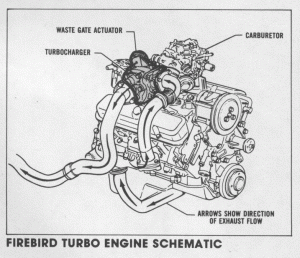
The 301 V8 was meant to be Pontiac’s new V8 – not its last one. It was designed to be much lighter and more fuel-efficient than the V8 it replaced, that had been around since the mid-1950s. The last of those – all 400s – had been installed in a relative handful of 1979 Trans-Ams, all of them with manual transmissions only. Today, these 1979 Trans-Ams are among the most collectible Trans-Ams and draw top dollar.
The 1980 Trans-Am offered a turbocharged version of the 301 – which became the Trans-Am’s top-dog engine that year. It was the first time since the ’60s that any American car company offered a turbocharged V8 – and it was offered then for the same reason that so many cars today come standard with turbocharged engines. It was a way for Pontiac to be able to continue offering what buyers wanted – power – while at the same time complying with federal regs pertaining to gas mileage and exhaust emissions (in those days, these were actual pollutants rather than the inert gas that was slyly branded an “emission” during the Obama years, so as to perpetuate the fiction that further regs were necessary).
In 2023, that doesn’t sound like much – especially from a turbocharged V8. Modern turbocharged fours often make at least that much – and quite a few make more. But 43 years ago, 200 horsepower – from anything – was a lot of power, relative to the power offered by other V8s of the era.
The 1980 Camaro Z28 still came standard with a 350 cubic-inch V8 that offered 190 horsepower. However, it was quicker than its Trans-Am sibling, in part because the Z28’s 350 could still be be paired with a manual transmission while the 1980 Trans-Am’s 301 turbo was automatic-only. Also, the 301 turbo had a turbo that was originally meant for a four cylinder engine that didn’t produce much boost and the whole set-up had to work with a carburetor, which rarely works well with a turbo.
But if one looked, one could see the potential.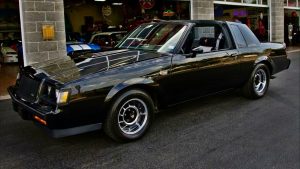
One can see the actuality – over at Buick (which yet survives, unlike Pontiac) where something similar was going on, except with a 231 cubic inch (3.8 liter) V6. Just like Pontiac, Buick was under pressure to find a replacement for displacement – in order to comply with federal regs.
And – like Pontiac – resorted to pressure.
A turbo was added to boost the power of the little V6, which eventually produced big power – approaching 300 horsepower by the late 1980s, in the Regal Grand National GNX, which was one the quickest cars available at the time (and is hugely collectible today).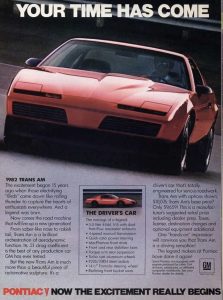
There were teething pains in between – and for the same reasons. But Buick was allowed by GM to persevere and given time, was able to massage the 231 V6 into one of the most successful and well-regarded engines GM ever offered.
Imagine what the 301 V8 might have become. With a proper turbo and fuel injection and electronic controls, it could have been one of the most powerful V8s of the ’80s. Imagine what it might have done for the 1982 Trans-Am, which was “all-new” that year but retained the off-center turbo-bulge hood scoop that made its debut in 1980. The ’82 TA had the same turbo-bulge because it was supposed to have come with the same turbocharged 301 that powered the 1980-1981 Trans-Am.
Instead, it got the same 305 cubic inch Chevy V8 that powered the 1982 Chevy Camaro Z28 – which made it a facade of what it no longer was. And – once again – the 1982 Trans-Am was not a bad car, because the 1982 Z28 was a good car. But it was no longer a Pontiac and while it did sell well for awhile, after awhile it began not to. Neither did what remained of the “Pontiac” lineup, which by the ’90s had become the same lineup, with different styling, that one found at Chevy (and Buick).
This was a problem for what was left of “Pontiac” because why shop for a Chevy or a Buick at a “Pontiac” dealership?
“Pontiac” stopped selling facades of the Trans-Am in 2002 and by 2010, GM stopped trying to sell “Pontiac,” which closed up shop (along with Oldsmobile, whose slow-motion demise had tracked similarly). Buick, however, survived and is still around, today.
Probably because GM didn’t kill it.
. . .
If you like what you’ve found here please consider supporting EPautos.
We depend on you to keep the wheels turning!
Our donate button is here.
If you prefer not to use PayPal, our mailing address is:
EPautos
721 Hummingbird Lane SE
Copper Hill, VA 24079
PS: Get an EPautos magnet or sticker or coaster in return for a $20 or more one-time donation or a $10 or more monthly recurring donation. (Please be sure to tell us you want a magnet or sticker or coaster – and also, provide an address, so we know where to mail the thing!)
My eBook about car buying (new and used) is also available for your favorite price – free! Click here. If that fails, email me at [email protected] and I will send you a copy directly!




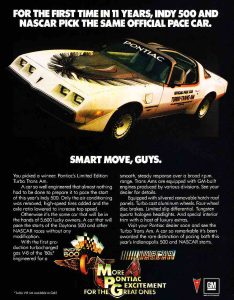







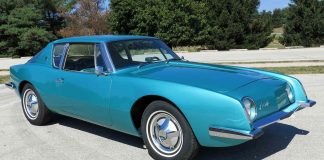
I think there’s a real lack of appreciation for the 5th Gen GTO and the Pontiac G8. For the G8, you could get them with a big V8 that made 355 to 400 hp, depending on model. These are absolute sleeper cars because the styling betrays what’s under the hood. Even today not many people realize the potential of these cars and you can get them fairly cheap.
Hi NT,
While I agree the rebadged/restyled Holden sold as a “GTO” was a fine performer (I know, I test drove one when it was new) and a sleeper, the problem – for Pontiac – was that it wasn’t a GTO. It was a rebadged/restyled Holden with a Chevy engine. The other problem is that it was expensive – whereas the whole concept of the original GTO was affordable performance. It is why young guys just out of high school or at least still in their 20s could afford the classic GTOs of the mid-1960s while for the most part it was older guys who bought the last “GTO,” because it took more money than mist guys under 40 had available.
Today, these cars are good deals – and even better as sleepers.
I bought a new 1982 Z28. It was one of the best handling cars I’ve driven, but ultimately it was boring due to the gutless 160hp 305. And it was a lemon. By 45K miles, it puffed blue smoke when started cold, the A/C had failed, the transmission was going out, it would randomly die at high elevations due to a gas tank venting issue, and it had electrical gremlins galore. I sold the Z28 when the 1986 S10 4×4 that l had special ordered from the factory came in. I still drive the S10. Had the Z28 been as quick and reliable as say, my 1997 Maxima, I’d have kept it.
The best engine in any 70’s or 80’s car, IMO, was not a Pontiac or Buick, but the Yamaha SHO in my 1989 Ford Taurus.
Hi Bart,
The Yamaha engine in the Taurus SHO was a gem; and the Taurus so equipped was the ultimate sleeper! I’m also a fan of the L69 HO 305 (190 hp) V8 that was available in the Z28 and Trans-Am in the early-mid ’80s. It had the L82 350 cam and was a revvy/powerful engine that was fun when paired with the manual transmission. It was also the last high-performance carbureted V8 GM ever offered. I miss being able to hear the Quadrajet moan…
Sparkey misses his ‘79 Gran Prix with the 301, and it was an efficient engine. With stock tune it would hit 22 MPG freeway cruise with the nasty 200 series 3 speed auto trans, no lockup.
By ‘79 to meet emissions they removed the power valve from the carb, no amount of tweaking would eliminate the cold engine bog, the vacuum controlled metering rods were ok when fully warmed up not before. I added a cold air bleed into the hot air choke feed, and re-plumbed the vacuum emissions sensors and valves to lock the distributor vac advance “on” until it warmed up. No bog but a nasty spark knock if you jumped on it cold! Removed the anti tamper plug from the metering rod adjuster, a 1/4 richer made for great drivability again when warmed up. (No emissions testing in my WA town back then).
301 had a steel timing gear, Pontiac finally abandoned the aluminum gear nylon toothed disaster that was guaranteed to fail as it did in my brothers ‘67 GTO 400 and my ‘70 Firebird 350. Someone in the ‘60s was nuts to dream that up!
When I think about what might have been had the Pontiac 301 had electronic fuel injection and, as you put it, “a proper turbo,” I’m bereft.
It would be no surprise if said engine put out 300-350 honest horsepower simply by virtue of having two more cylinders and 70 more cubic inches of displacement—downright impressive by 1980s standards.
It sure would differentiate the Trans Am Firebird from the Z28 Camaro—‘cause you can’t get it in anything else. Who knows, that engine could have spawned 1980s versions of the GTO and 2+2.
But GM took the cheap and lazy approach of badge engineering to the point that people thought “PONTIAC” stood for “People Often Notice That It’s A Chevy.” Which is what they were without the plastic cladding and the “flared nostrils” front ends.
And don’t get me started on Oldsmobile…
Pontiac was a chief for an indigenous North American tribe.
The decision to scrap the make was definitely racist. Not fair, the fed gov has to pay reparations to the Ottawa tribe, 10 trillion dollars should do it.
While Biden falls now and then, the count goes higher. Looks almost biblical, you know, hey. Might even be an allegory. The body count isn’t high enough yet, Charles Manson demands more!
Pride goeth before fall.
Some proverb from some book somewhere.
“Pride goeth (goes) before destruction, and an haughty spirit before a fall”. From the Christian Bible, Proverbs chapter 16, verse 18. I could apply that to a bunch of politicians I know….
Today’s engines are designed with the equivalent of a blackjack player’s basic strategy. Back in the 1970s computer science was enamored with the idea of computers cracking card games by calculating all the possible scenarios for every hand. A classic “small world” problem to solve. The closest they came was to figure out how to even out the odds on blackjack. Combined with counting a player would gain a 1% advantange if he played perfectly. These days a good dealer will even explain BS (but not counting) to novice players just to keep them playing. Without counting the player will still lose but more slowly. Of course these days the casinos ruined a good thing by changing payouts and continous shuffle, but that’s a whole different topic…
Same sort of thing happened in mechanical engineering. 500cc cylinder volume just worked out to be ideal for gasoline combustion. So that became the base. Then it was just a matter of adding cylinders, all the way up to the VW W-16 in the Bugatti Veyron. Maybe make a few adjustments to valve timing and cam lobe shapes. Turbo and super charging is a little like overclocking. Like overclocking your computer, too much boost can break things, but a little will get you something for nothing… with extra plumbing.
https://www.autoweek.com/car-life/a35694550/heres-why-seemingly-every-automaker-has-a-20-liter-four-in-the-lineup/
In a way it makes sense. Internal combustion piston engines have been around for 150 years. What hasn’t been tried? I’m sure there’s some esoteric build that would have some minor advantage, but why bother? I’m sure there are blackjack players who think they’ve come up with something better than basic strategy too, and maybe for some certain scenario it’s better. But in today’s automaker, going against “basic engines” isn’t the hill to die on. Especially when most car reviewers spend more time talking about the instrument cluster and seats than what’s under the hood.
“The EcoBoost strategy has really served us well since we rolled it out in the mid to late 2000s,” Hau Thai-Tang told us.
Maybe it worked well for Ford, but how about for the customers?
Buddy of mine bought a Ford pickup with EcoBoost to pull a 25-foot trailer. By the time it hit 45,000 miles, still within warranty, the overstressed little engine developed serious valve train problems which took the dealer weeks to fix. Also, it got a terrible 8-9 mpg on the uphill run from PHX.
He traded it for a Ram Hemi V8. Not only is the big 5.7-liter engine not straining as hard as the little EcoBoost, it’s 2-3 mpg better on gasoline consumption as well.
Let’s amend Thai-Tang’s statement: “The EcoBoost strategy has really served us well for regulatory compliance.”
Big Gov’s alright, jack. Too bad about its lowly little citizens. Let them drive rickshaws.
I had a Pontiac Grand Am for a while in the 90s. It was a rebadged Corsica, I think. Way underpowered, but otherwise it got me from A to B. That was its most redeeming quality.
BTW, when I win the lottery I’m buying a Buick GNX.
I had one of them in the early ’00s. Bland and boring transportation. Odd things broke, like the driver’s power window and power steering pump (plastic pulley shaft snapped off one cold morning). Finally got rid of it after the DEXCOOL coolant ate away the silicone head gasket, requiring a major engine teardown. Some people tried to get a recall and later class-action but I think most of the cars didn’t last long enough for it to become an issue. I got 10 years out of the thing, but didn’t get much over 100,000 miles out of it either. A good car, if you have a company vehicle.
I had a 2002 Pontiac Grand AM. It was the worst car I ever owned. Paid it off early, thankfully, and them promptly traded it in (along with a nice, down payment) for my long-since-paid for WRX, which I never regretted buying, and got five times the miles out of the WRX, than I ever did the Pontiac. Even my three banger, Geo Metro (from long, long ago) ran better, and I got twice the miles out of that one, than I did the Pontiac. Now how sad is that? That a pregnant, three-cylinder roller-skate (as I called it)-which probably had less “oomph than my old snow machine-could outlive and out run a Pontiac? Truly pathetic. As the saying goes, “they don’t make ’em like they used to.
Excellent article, history lesson and of what could’ve been.
But, the greatest criminal act that lead to Pontiac’s demise was the loan shark bankruptcy deal that GM made with the criminal US FEDGOV, to keep GM in business.
Prez.’s Georgie Dubya, and his follow-on, Osambo and their henchmen mandated GM get rid 3 divisions, IIRC.
So, Pontiac, Hummer, and Saturn were sold off or killed because of Unka Sambo’s interference and demands.
And what coulda-shoulda-woulda been, had GM learned from the market and gotten their collective act together, now will NEVER be….because of US FEDGOV interference!!!
Didn’t Obama also let the bond holders of GM know they are no longer first in line to get paid as creditors, which changed the private bond market forever. As I recall, Obama accused them of being greedy. How Stalin of him.
I think the bond holders got shafted when they only got paid back 10 cents on the dollar. The UAW got got the sweetheart deal. After the bailout, GM pulled a “Nixon” and went to China.
‘because of US FEDGOV interference!!!’ — Saxons Wrath
Fedgov meddling goes way back. From Brooks Brierley’s Magic Motors 1930:
‘At the end of 1933 the National Recovery Act [prompted] the Motor Vehicle Retailing Trade Code. Establishments had to be kept open a minimum of 52 hours a week; minimum pay for labor was 40 cents an hour.
‘Automobiles sold as demonstrators had to be registered with a local trade association and not sold for less than full price until used at least 60 days and operated for 3,500 miles.
‘More damaging was the fixing of used car [trade-in] allowances [to prevent indirect discounting].’
Back then, Big Gov was fighting deflation. So it tried to drive up the prices of food, cars, you name it.
Ninety years on, it’s driving up the price of mandated EeeVees, whether people can afford them or not.
Big Gov’s counterproductive meddling never changes, and never fixes anything.
Governments love auto manufacturers. Aerospace too, if the population is able. They’re seen as an indicator of being a successful economic system. Also good to have heavy industry on hand in case of a kenetic war.
China just built a knock-off 737. Why? Well, because now Xi has something to show off. “Look what we’ve done! China no longer second class! Soon take over America! You thank CCP now!” Certainly building a commercial airliner is a great accomplishment. And it is probably not a big drag on the Chinese economy, like it is in Europe. But is recreating a 50 year old airframe the best way to advance aviation? Of course we all know that Bastiat’s “unseen” might have been far better than the Chinese 737.
So we continue to see all nations subsidize their favorite manufacturers. And they continue to churn out bland, boring identical vehicles. Because why would you upset the apple cart? Racing used to be the test track, not an extension of the marketing department, and race cars were all different. Now they’re all identical and bland, and auto racing is no more a sport than pro wrestling. Just leave the R&D to the government’s universities, where anything goes, no matter how impractial. Then when the politicans get their executive summary from the think tanks, they decide the risk. Manufacturers just build cars. If they don’t sell, well, that’s someone else’s problem.
Another little car from Pontiac was the the Fiero. If GM had extended the model a little longer so it could use the Quad-4 engine, that car would’ve been a real performer. The last non-Chevy V8 engine that was used was the Olds 307 and I think that engine ran in production until 1990.
Off topic, but somewhat urgent. I can’t open Zero Hedge this morning. Any body else?
I got in, as of 7 central time
It’s there, here anyhow.
Finally opened for me when I tried at 8 am central.